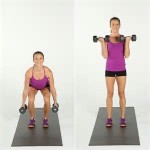Get Functional!
If you’re having trouble lifting or carrying, try adding a Squat with a Bicep Curl to your workout routine:
Stand with your feet hip width apart. Hold a weight on either side of your body. Bending from your knees and hips, lower your body down about 12 inches, keeping your elbows straight. Upon standing up, bend both arms into a bicep curl. Repeat the squat and extend your elbows again.
If you’re having trouble bending or reaching, add a One Leg-Hold and Reach to your exercise outline:
Stand on your right leg only. Stabilize your torso and reach your arms forward, without losing your balance. Hold for 2-3 seconds, then return to your standing upright position. Do 10 reps. Then, switch and stand on your left leg only, reach forward and hold.
*Consult your physician before performing exercise.
 Subscribe
Subscribe
